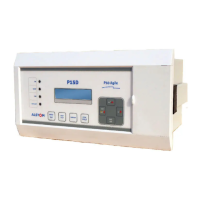timer to zero, the overcurrent timer for that stage will reset instantaneously as soon as the current falls
below a specified percentage of the current setting (typically 95%).
Another possible situation where the timer hold facility may be used to reduce fault clearance times is
for intermittent faults. An example of this may occur in a plastic insulated cable. In this application it is
possible for the fault energy to melt and reseal the cable insulation, thereby extinguishing the fault.
This process repeats to give a succession of fault current pulses, each of increasing duration with
reducing intervals between the pulses, until the fault becomes permanent.
When the reset time is instantaneous, the device will repeatedly reset and not be able to trip until the
fault becomes permanent. By using the Timer Hold facility the device will integrate the fault current
pulses, thereby reducing fault clearance time.
The timer hold facility is available to all three stages of OC and EF functions.
The Definite Time Reset characteristic is applicable for IEC curves / DT.
The value of the Reset Timer depends on the type of the timer associated to the pick-up phase (Earth)
threshold.
Type of timer associated with phase (earth)
threshold
Reset Timer
Self-Powered
- For DT time delay DT
- For IDMT time delay DT
Aux. Powered
- For DT time delay DT
- For IDMT time delay DT
The range of DT time setting is 0 – 100 sec in steps of 0.01 sec.
Note: For aux. powered P15D relay, if load current reduces below minimum value required to keep relay
energised, then the HOLD/RESET timer will reset to zero.
2.2 Thermal Overload Function
The heat generated within an item of plant, such as a cable or a transformer, is the resistive loss
(I
2
Rt). The thermal time characteristic is therefore based on the square of the current integrated over
time. The device automatically uses the largest phase current for input to the thermal model.
The equipment is designed to operate continuously at a temperature corresponding to its full load
rating, where the heat generated is balanced with heat dissipated. Over-temperature conditions occur
when currents in excess of their maximum rating are allowed to flow for a period of time. It is known
that temperature changes during heating follow exponential time constants.
The device provides single time constant characteristic which is used to protect cables, dry type
transformers (e.g. type AN), and capacitor banks.
Thermal overload protection is designed to prevent the electrical equipment when operating
temperature is exceeded the maximum designed temperature. The fundamental currents are
measured and analysed to monitor the thermal state. In case of thermal overload function the
calculation of the Time to Trip is given by:
t = τ ln ((K²- A)/ (K²- Th. Trip))
Where:
t: Time to trip (in seconds)
τ: Thermal time constant (Te, in seconds) of the equipment to be protected

